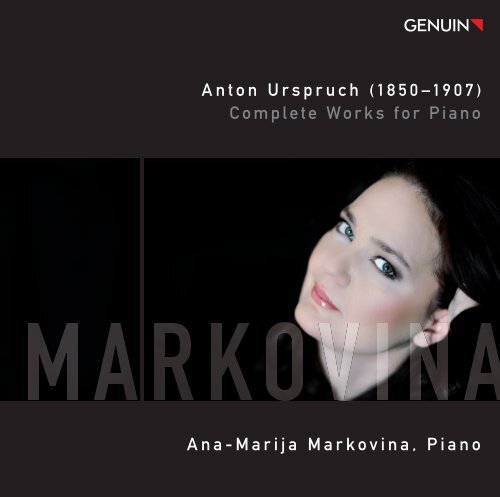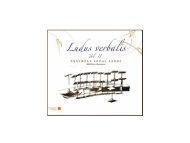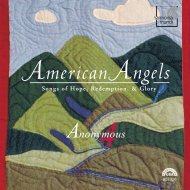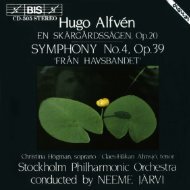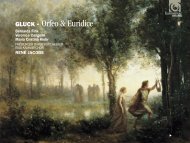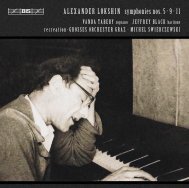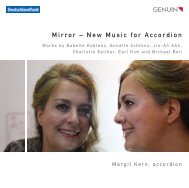Anton Urspruch (1850–1907) Complete Works for Piano ... - eClassical
Anton Urspruch (1850–1907) Complete Works for Piano ... - eClassical
Anton Urspruch (1850–1907) Complete Works for Piano ... - eClassical
You also want an ePaper? Increase the reach of your titles
YUMPU automatically turns print PDFs into web optimized ePapers that Google loves.
<strong>Anton</strong> <strong>Urspruch</strong> (<strong>1850–1907</strong>)<br />
<strong>Complete</strong> <strong>Works</strong> <strong>for</strong> <strong>Piano</strong><br />
Ana-Marija Markovina, <strong>Piano</strong>
<strong>Anton</strong> <strong>Urspruch</strong> (<strong>1850–1907</strong>)<br />
<strong>Complete</strong> <strong>Works</strong> <strong>for</strong> <strong>Piano</strong>, Volume 1<br />
CD 1<br />
Cinq Morceaux pour le <strong>Piano</strong>, Op. 19<br />
01 Air . . . . . . . . . . . . . . . . . . . . . . . . . . . . . . . . . . . . . . . . . . . . . . . . . . . [06'56]<br />
02 Impromptu . . . . . . . . . . . . . . . . . . . . . . . . . . . . . . . . . . . . . . . . . . . [08'12]<br />
03 Romance . . . . . . . . . . . . . . . . . . . . . . . . . . . . . . . . . . . . . . . . . . . . . [06'29]<br />
04 Caprice . . . . . . . . . . . . . . . . . . . . . . . . . . . . . . . . . . . . . . . . . . . . . . [05'34]<br />
05 Fantasie . . . . . . . . . . . . . . . . . . . . . . . . . . . . . . . . . . . . . . . . . . . . . . [05'19]<br />
Cavatine und Arabeske für das <strong>Piano</strong><strong>for</strong>te, Op. 20<br />
06 Cavatine . . . . . . . . . . . . . . . . . . . . . . . . . . . . . . . . . . . . . . . . . . . . . [05'50]<br />
07 Arabeske . . . . . . . . . . . . . . . . . . . . . . . . . . . . . . . . . . . . . . . . . . . . [06'16]<br />
Total Time<br />
. . . . . . . . . . . . . . . . . . . . . . . . . . . . . . . . . . . . . . . . . . . . . . . . . . . . . . [44'38]<br />
2
CD 2<br />
Fünf Fantasiestücke für das <strong>Piano</strong><strong>for</strong>te, Op. 2<br />
01 In ruhiger Bewegung—Rascher, leicht und lebendig— . . . . [13'44]<br />
Wie zu Anfang—Sehr ruhig und mild—Wie zu Anfang-<br />
Langsam, träumerisch<br />
02 Sehr lebhaft kühn und trotzig . . . . . . . . . . . . . . . . . . . . . . . . . . [05'49]<br />
03 Sehr langsam und ausdrucksvoll . . . . . . . . . . . . . . . . . . . . . . . [03'44]<br />
04 Mit Kraft und Feuer . . . . . . . . . . . . . . . . . . . . . . . . . . . . . . . . . . . [09'43]<br />
05 Stürmisch und leidenschaftlich—etwas mässiger, . . . . . . . . [13'51]<br />
leicht und graziös—Wie zu Anfang—Frisch und lebendig—<br />
Rascher, sehr flüchtig—Frei und fantastisch—<br />
Wie zu Anfang<br />
Total Time . . . . . . . . . . . . . . . . . . . . . . . . . . . . . . . . . . . . . . . . . . . . . . . . . . . . . . [46'54]<br />
3
Virtuosity and authenticity:<br />
The composer <strong>Anton</strong> <strong>Urspruch</strong><br />
Who was <strong>Anton</strong> <strong>Urspruch</strong>?<br />
First of all, he is a composer, pianist and conductor who plays an unjustifiably marginal role<br />
in our contemporary consciousness.<br />
He was born on February 17, 1850 in Frankfurt, and died there on January 11, 1907.<br />
This time period identifies him as an artist in an age whose spiritual accents have many<br />
dimensions whose most striking characteristic, from a psychological point of view too, lies<br />
in looking back to the past, on the one hand, and on the other in a revolutionary anticipation<br />
of the future.<br />
<strong>Urspruch</strong> was an artist held in high esteem by his contemporaries and well established<br />
in the scene. As a 28-year-old he was already a faculty member at Dr. Hoch’s Konservatorium<br />
at the same time Clara Schumann was teaching there. The director of the Conservatory<br />
was Joachim Raff, who was also his teacher. <strong>Urspruch</strong> taught until his death at the laterestablished<br />
(after Raff’s death in 1882) Raff Conservatory. He dedicated his <strong>Piano</strong> Concerto<br />
to Raff. <strong>Urspruch</strong>’s works cover many genres from works <strong>for</strong> piano to song cycles, chamber<br />
music, symphonies, choral works and opera (Das Unmöglichste von allem, which had its<br />
premiere in Karlsruhe in 1897). His family (four daughters with the daughter of the music<br />
publisher A. Cranz, Emmy Cranz) was the center of his life.<br />
Friendship and support going far beyond the usual respect <strong>for</strong> his ability from his more<br />
famous and older colleague bound him to Franz Liszt: “With Liszt I experienced a level of<br />
4
acceptance which I could not have imagined even in my wildest dreams. He liked my compositions<br />
exceptionally well and embraced and kissed me tempestuously again and again—<br />
he likes me just as much as a pianist. I am his daily guest and we make music together <strong>for</strong><br />
hours; on Monday we played no less than six complete hours.” (letter to the Frankfurt concertmaster<br />
Hassel-Barth on May 24, 1871)<br />
Fin de siècle<br />
The fin de siècle offered artists in all domains new perspectives and experiments, which led<br />
to a new aesthetic whose consciousness of <strong>for</strong>m always also transported symbolic contents.<br />
The perfectly mastered <strong>for</strong>m (whether in painting or music) was searching <strong>for</strong> a deeper<br />
content-related justification, and thus not infrequently transcended the present. This present<br />
was completely materialistic, both politically and socially. The triumphs of natural sciences<br />
and the steel industry and new <strong>for</strong>ms of banking, produced a cultural climate that<br />
impresses us today through its predicaments: This can be seen best of all in the architecture<br />
of the period 1871–1914. Official and private buildings competed in pomp and the representational<br />
character they expressed. But they did not develop a language of their own. The<br />
Middle Ages, the Romanic and Gothic period, the Renaissance and Baroque had to surrender<br />
their standards. It was similar in painting: The Pre-Raphaelites in England as their<br />
name already indicates, swore by the Middle Ages, symbolism and the various styles related<br />
to Jugendstil in different European regions were fascinated by the myths and legends of<br />
past ages. The Romantic period was already familiar with this preoccupation with the past,<br />
but it was only in the late 19 th century, against the background of the rise of industry, that<br />
there was a comprehensive aesthetic landscape in this sense. Anyone who could af<strong>for</strong>d it,<br />
5
and the magnates of industry, banking and the media could, built castles and houses that<br />
are reminiscent of cathedrals, and the Americans disassembled historical buildings in Europe<br />
and shipped their numbered parts home, where they were re-assembled.<br />
That was all carried out with perfect craftsmanship and still impresses us today<br />
through its lack of aesthetic misgivings, but what has that got to do with <strong>Anton</strong> <strong>Urspruch</strong>?<br />
The musician<br />
<strong>Urspruch</strong> was a witness of this epoch and had to establish himself as a musician. He shared<br />
this task with all artists of his time, regardless of which domain they were located in. The<br />
guiding values <strong>for</strong> him and his colleagues are well characterized by the concepts virtuosity<br />
and authenticity. First of all, the period had challenging examples; Kalkbrenner, Moscheles<br />
and above all Liszt set standards of mastery of their instrument that were unknown in earlier<br />
epochs.<br />
The piano had greatly changed its role since Mozart and Haydn, both in terms of its<br />
construction and the role it played in concerts and how such concerts were organized. Salons,<br />
at first of the nobility and then of the middle class, took a central position, and the role<br />
of composers followed this change: from that of court musicians to independent entrepreneurs,<br />
who had to manage their network of admirers and patrons themselves. Something<br />
of this is already to be found with Beethoven in his dedications; Schumann and Chopin<br />
perfected this new identity, the <strong>for</strong>mer diversifying his entrepreneurial activities by working<br />
as a magazine publisher and literary figure.<br />
6
Virtuosity<br />
Virtuosity was and became more and more an economic factor which, however, as such had<br />
to remain unnamed. It was kept hidden by the admiration <strong>for</strong> geniuses, just as the rituals of<br />
the concert are intended to make the material background invisible. The celebration, often<br />
with a liturgical aura, dominates the scene.<br />
The epitome of this spirit is without a doubt Franz Liszt. He is the focus of European admiration<br />
and Danhauser’s painting of a gathering of great figures of the musical world who<br />
had never met in such a constellation can quite readily be seen as a summary of excellent<br />
networking. Interesting in this connection, not least because a sacred-erotic mood underlies<br />
the whole thing.<br />
Authenticity<br />
Joseph Danhauser<br />
“Memories of Liszt” (1840)<br />
This brings us to the second concept: authenticity.<br />
There is a tension between virtuosity<br />
and authenticity which always has the<br />
tendency to become difficult <strong>for</strong> the latter.<br />
The artistic element of virtuosity has a<br />
direct and unaltered connection to the mercantile<br />
side of art: Both yesterday (and what<br />
is meant is the time of Liszt and <strong>Urspruch</strong>)<br />
and today this element, which is easily understandable<br />
and capable of being com-<br />
7
municated to any audience, is given clear preference in the business of organizing classical<br />
music concerts. It already begins at the level of the competitions, which in their present <strong>for</strong>m<br />
are direct elements of a modernity with which <strong>Urspruch</strong> was already familiar: “The modern<br />
person, the modern artist – an almost sad-sounding word! It is such a keen reminder of<br />
our transitoriness. For only what has its origin in fashion – this fashion which Schiller<br />
stigmatized as impertinent – is “modern,” and fashion is fashion today because yesterday<br />
it was not and tomorrow it will not be. Thus, everything based on fashion is not modern, it<br />
is in a state of decay. There<strong>for</strong>e do not be so proud, modern musician, of your present-day<br />
music!” These are the words of <strong>Anton</strong> <strong>Urspruch</strong> in a study of Gregorian chant in the Berlin<br />
Allgemeine Musik-Zeitung.<br />
Authenticity is always a quest and a struggle, denial of short-term economic gratification<br />
(money, fame, virtuosity) and not least consciousness of tradition going beyond the<br />
pre-determined modules stamped out by one’s own biography and environment. The Protestant<br />
<strong>Urspruch</strong> came to appreciate plainchant, entered into a lively correspondence with<br />
Benedictine church musicians and abbots all the way to leading clerics in the Vatican and a<br />
private audience with Pope Pius X. This <strong>for</strong>m of music is a fascinating element in the sense<br />
of the historical quest <strong>for</strong> authenticity of his day and age: the purest <strong>for</strong>m of music, song in<br />
a transcendental <strong>for</strong>m unsullied by modernism and materialism. <strong>Urspruch</strong>’s patron Liszt<br />
sought a similar transcendence: In his late works the titan of the salons turned, in the vestments<br />
of an abbot, to religious themes. His son-in-law, Richard Wagner, was not religious,<br />
but gave <strong>for</strong>m to the Christian myths, <strong>for</strong> instance in his Parsifal.<br />
<strong>Urspruch</strong>’s piano compositions do not reflect this thematic focus in a direct sense, to be<br />
sure, but they can be understood as a journey in search of authenticity, all the same: The piano<br />
virtuoso knows all the secrets of his trade; the pieces have close to unplayable passages.<br />
8
Ana-Marija Markovina interprets this diversity of pianistic culture, which in the end<br />
is quite simple: an apotheosis of song in which she unerringly traces all contradictions and<br />
unexpected twists. At the same time she pays attention to the spiritual Hermeticism as well<br />
as to the obvious tonal message, which, despite all harmonic challenges, <strong>Urspruch</strong>’s music<br />
always bears.<br />
A composer of great compositional power comes alive <strong>for</strong> us in Markovina’s interpretation.<br />
Prof. Dr. Helmut Reuter, Bremen University<br />
(Translation: Matthew Harris)<br />
9
Ana-Marija Markovina, <strong>Piano</strong><br />
“Her outstanding pianistic style was revealed in the per<strong>for</strong>mance of Franz Liszt, stirring<br />
memories of Paganini’s virtuoso playing, transferred to the piano.”<br />
Westfälische Rundschau<br />
Ana-Marija Markovina is an authentic and unconventional artist whose career<br />
was guided by important teachers from the very beginning. Born in Croatia she<br />
initially studied in the tradition of the Russian School with Vitaly Margulis and<br />
Anatol Ugorski, gained even more pianistic insights from Rolf-Dieter Arens at<br />
the Franz-Liszt Hochschule in Weimar, and then studied with Paul Badura-Skoda in Vienna<br />
be<strong>for</strong>e she completed her studies with a Solo <strong>Piano</strong> Per<strong>for</strong>mance degree from the Hochschule<br />
für Musik “Hanns Eisler” in Berlin.<br />
Important stages in her international concert career were her debut in Japan with the<br />
New Japan Philharmonic Orchestra at the International <strong>Piano</strong> Festival in Yokohama, as a<br />
result of which she was invited to the most important music centers in Japan such as, <strong>for</strong><br />
example, Tokyo, Kyoto, Osaka, Sapporo, and Nagoya. Among other things, she appeared<br />
as soloist with the Oulu Symphony Orchestra in Finland, with the Stettin Philharmonic<br />
Orchestra Poland, the Romanian Radio Orchestra Bucharest, and the Kaunas Symphony<br />
Orchestra, and was a guest artist at important festivals including the 15 th International<br />
<strong>Piano</strong> Stars Festival in Latvia, which she opened in 2007 with Tchaikovsky’s Third <strong>Piano</strong><br />
Concerto, at the Schleswig-Holstein Music Festival, the <strong>Piano</strong> Festival Ruhr, the Brandenburg<br />
Summer Concerts, the Musikfesttagen C. Ph. E. Bach in Frankfurt an der Oder and the<br />
European Festival Weeks in Passau.<br />
10
Her appearances have already taken her to almost all European countries, Japan und<br />
the United States. She has played as a soloist in the most important cultural centers of Europe,<br />
including the Berlin Philharmonie, the Gasteig in Munich, St. John’s Smith Square<br />
in London, the Auditorium in Milan, in Rome, Amsterdam, Luxemburg, Brussels, Thessaloniki,<br />
Sofia, Kiev, and St. Petersburg, to name only a few. In March 2008 she per<strong>for</strong>med<br />
her debut concert at Vienna’s Musikverein. In the meantime, she has built up a repertoire of<br />
over 50 piano concertos.<br />
Numerous CD recordings and appearances on radio and television document her high<br />
level of artistry.<br />
Highly praised by the classical music press, a disc of Six Württembergische Sonatas by<br />
Carl Philipp Emanuel Bach marked her recording debut with GENUIN in early 2006, and<br />
was soon followed by a release of piano works by Robert Schumann.<br />
In 2007 the widely praised first recording of all the finished piano works by Hugo Wolf<br />
was released, and in September 2008 her CD with the Prussian Sonatas by C. Ph. E. Bach.<br />
Paul Badura-Skoda calls her “one of the most significant artists of her generation.”<br />
www.pianistin.com<br />
11
Virtuosität und Authentizität:<br />
Der Komponist <strong>Anton</strong> <strong>Urspruch</strong><br />
Wer war <strong>Anton</strong> <strong>Urspruch</strong>?<br />
Zunächst einmal ist er ein Komponist, Pianist und Dirigent, der in unserem zeitgenössischen<br />
Bewusstsein eine zu Unrecht marginale Rolle spielt.<br />
Geboren ist er am 17. Februar 1850 in Frankfurt und gestorben dort am 11. Januar<br />
1907. Diese Zeitspanne weist ihn als Künstler einer Epoche aus, deren geistige Akzente vielfache<br />
Dimensionen haben, deren auch psychologisch bedeutsamste in der Rückbesinnung<br />
einerseits und der revolutionären Vorausschau andererseits zu finden sind.<br />
<strong>Urspruch</strong> war ein von seinen Zeitgenossen geschätzter Künstler, in der Szene wohl etabliert.<br />
Schon als 28-jähriger war er Dozent am Hoch’schen Konservatorium, zu der Zeit als<br />
auch Clara Schumann dort lehrte. Der Leiter dort war Joachim Raff, auch sein Lehrer. Am<br />
später (nach Raffs Tod 1882) gegründeten Raff-Konservatorium unterrichtete <strong>Urspruch</strong> bis<br />
zu seinem Tod. Raff widmete er sein Klavierkonzert. Seine Werke umfassen viele Sparten,<br />
vom Klavierwerk über die Liederzyklen, Kammermusik, die Symphonien, Chorwerke und<br />
die Oper („Das Unmöglichste von allem“, 1897 in Karlsruhe uraufgeführt). Seine Familie<br />
(vier Töchter mit der Tochter des Musikverlegers A. Cranz, Emmy Cranz) war ihm Lebensmittelpunkt.<br />
Mit Franz Liszt verband ihn Freundschaft und Förderung weit über die übliche Wertschätzungen<br />
seitens des Berühmteren und Älteren hinaus: „Bei Liszt fand ich eine Aufnahme,<br />
welche ich mir auch bei den kühnsten Träumen nicht hätte ahnen laßen können.<br />
12
Meine Compositionen haben ihm ganz außerordentlich zugesagt und umarmte und küsste<br />
er mich ein übers andere Mal stürmisch – ebenso gefalle ich ihm als Pianist. Ich bin sein<br />
täglicher Gast und musizieren wir mehrere Stunden zusammen, Montag spielten wir nicht<br />
weniger als sechs geschlagene Stunden.“ (Brief an den Frankfurter Konzertmeister Hassel-<br />
Barth vom 24.5.1871)<br />
Fin de Siècle<br />
Das Fin de Siècle hält für die Kunstschaffenden aller Domänen neue Perspektiven und Experimente<br />
bereit, die in eine neue Ästhetik münden, deren Formbewusstsein immer auch<br />
symbolische Inhalte transportiert. Die perfekt beherrschte Form (sei es in der Malerei oder<br />
der Musik) sucht nach tieferer inhaltlicher Begründung und transzendiert damit nicht<br />
selten die Gegenwart. Diese Gegenwart ist politisch und gesellschaftlich durch und durch<br />
materialistisch. Die Triumphe der Naturwissenschaft und der Stahlindustrie, neue Formen<br />
des Bankwesens, lassen ein kulturelles Klima entstehen, das uns heute durch Verlegenheit<br />
imponiert: Am besten ist das an der Architektur der Gründerzeit zu sehen. Die offiziellen<br />
und privaten Bauten wetteifern im Pomp und der veräußerlichten Repräsentativität. Aber<br />
sie findet keine eigene Sprache. Das Mittelalter, die Romanik und Gotik, Renaissance und<br />
das Barock müssen ihre Maßstäbe zur Verfügung stellen. Der Malerei geht es ähnlich: Die<br />
Präraffaeliten in England beschwören, wie ihr Name schon sagt, die Zeit des Mittelalters.<br />
Der Symbolismus und Jugendstil(e) der verschiedenen europäischen Regionen sind fasziniert<br />
von Mythen und Sagen vergangener Zeiten. Schon die Romantik kannte diese Vergangenheitssehnsucht,<br />
aber erst jetzt, im späten 19. Jahrhundert, gibt es, auf dem Hintergrund<br />
13
der Industrie, eine umfassende ästhetische Landschaft in diesem Geist. Wer es bezahlen<br />
kann, und die Magnaten der Industrie, des Bankwesens und der Medien können es, baut<br />
sich Burgen und Häuser, die an Kathedralen erinnern und die Amerikaner bauen die historischen<br />
Gebäude in Europa ab und verschiffen die Teile nummeriert nach Hause, wo sie<br />
sie wieder aufbauen.<br />
Das alles ist handwerklich perfekt und beeindruckt uns in seiner ästhetischen Unbedingtheit<br />
bis heute, aber was hat das mit <strong>Anton</strong> <strong>Urspruch</strong> zu tun?<br />
Der Musiker<br />
<strong>Anton</strong> <strong>Urspruch</strong> ist Zeuge dieser Epoche und musste als Musiker seinen Platz finden. Diese<br />
Aufgabe teilte er sich mit allen künstlerisch Tätigen seiner Zeit, gleichgültig in welcher Domäne<br />
sie sich befanden. Eckpunkte, um die es ihm und seinen Kollegen ging, sind mit den<br />
Begriffen Virtuosität und Authentizität gut umschrieben. Zum Ersten hat die Zeit heraus<strong>for</strong>dernde<br />
Beispiele: Kalkbrenner, Moscheles und an erster Stelle Liszt stellten Forderungen<br />
an die Instrumentbeherrschung, die den vorigen Epochen fremd waren.<br />
Das Klavier hatte seine Rolle sowohl von der Technik seines Baus als auch von den<br />
Konzertanlässen und -gestaltungen seit Mozart und Haydn sehr verändert. Der erst adlige,<br />
dann bürgerliche Salon rücken in den Mittelpunkt und die Rollen der Komponisten folgen<br />
diesem Wandel: vom Hofkünstler zum selbständigen Unternehmer, der das Netzwerk seiner<br />
Bewunderer und Förderer selbst zu managen hat. Bei Beethoven finden wir in seinen Widmungen<br />
schon etwas davon; Schumann und Chopin vervollkommnen diese neue Identität,<br />
wobei ersterer sein Unternehmertum als Zeitschriftenherausgeber und Literat diversifiziert.<br />
14
Virtuosität<br />
Virtuosität ist und wird mehr und mehr ein Wirtschaftsfaktor, der als solcher aber unbenannt<br />
bleiben muss. Er wird durch die Genieverehrung verborgen wie überhaupt die Rituale<br />
des Konzerts auf eine Unsichtbarkeit der materiellen Hintergründe zielen. Das Fest mit<br />
oft liturgischer Aura bestimmt die Szene.<br />
Repräsentant dieses Geistes ist ohne Zweifel Franz Liszt. Er ist das Zentrum europäischer<br />
Verehrung und man kann gut und gern Danhausers Gemälde als Versammlung so nie<br />
zusammengekommener Größen der Musikwelt als eine Zusammenfassung hervorragenden<br />
Networkings betrachten: Interessant in unserem Zusammenhang nicht zuletzt dadurch,<br />
dass eine sakral-erotische Stimmung das ganze grundiert.<br />
Authentizität<br />
Joseph Danhauser<br />
„Erinnerung an Liszt“ (1840)<br />
Damit sind wir beim zweiten Begriff angelangt:<br />
der Authentizität. Virtuosität und<br />
Authentizität stehen in einem Spannungsverhältnis,<br />
welches immer die Tendenz hat,<br />
prekär für letztere zu werden.<br />
Das artistische Element der Virtuosität<br />
hat einen direkten und unverfälschten<br />
Bezug zur merkantilen Seite der Kunst:<br />
Gestern (und das meint die Zeit Liszts und<br />
<strong>Urspruch</strong>s) und heute ist dieses Element<br />
15
leicht verständlich und jedem Publikum umstandslos zu vermitteln, hoher Favorit in der<br />
Organisation des Konzertbetriebs. Das beginnt schon auf der Ebene der Wettbewerbe, die<br />
in ihrer heutigen Form direkte Element einer Moderne sind, die auch <strong>Urspruch</strong> schon kannte:<br />
„Moderner Mensch, moderner Künstler – ein fast traurig klingendes Wort! Es gemahnt<br />
so sehr an das Vergängliche. Denn ‚modern‘ ist nur, was in der Mode – dieser mit Recht von<br />
Schiller als frech gegeißelten Mode – seine Ursache hat, und Mode ist darum heute Mode,<br />
weil sie gestern keine war und morgen keine mehr sein wird. Modernd, nicht modern,<br />
müsste darum Alles heißen, was sich in ihr gründet. Thue darum nicht so stolz, moderner<br />
Musiker, mit deiner Musik der Gegenwart!“ So <strong>Anton</strong> <strong>Urspruch</strong> in einer Studie über den<br />
gregorianischen Choral in der Berliner „Allgemeinen Musik-Zeitung“.<br />
Authentizität ist immer Suche und Kampf, Verweigerung der naheliegenden ökonomischen<br />
Gratifikationen (Geld, Ruhm, Virtuosität) und nicht zuletzt die Besinnung auf<br />
die Tradition jenseits der vorgestanzten Module der eigenen Biographie und Umgebung.<br />
So findet der Protestant <strong>Urspruch</strong> zur Gregorianik, tritt in lebhafte Korrespondenz zu den<br />
benediktinischen Kirchenmusikern und Äbten bis hin zu führenden Klerikern des Vatikan<br />
und einer Privataudienz bei Papst Pius X. Diese Musik<strong>for</strong>m ist ein Faszinosum im Geist der<br />
historischen Authentizität-Suche seiner Epoche: die reinste Form der Musik, der Gesang in<br />
einer transzendenten von Moderne und Materialismus unbefleckten Form. Eine ähnliche<br />
Transzendenz sucht <strong>Urspruch</strong>s Förderer Liszt: im Spätwerk wendet sich der Salon-Titan<br />
im Gewand des Abbés religiösen Themen zu. Sein Schwiegersohn Richard Wagner ist nicht<br />
religiös, gestaltet aber die christlichen Mythen, z. B. in seinem Parsifal.<br />
<strong>Urspruch</strong>s Klavierwerk spiegelt nun diese Thematik im direkten Sinn nicht wider, im<br />
Sinn einer Authentizitätsreise ist es aber allemal zu verstehen: Der pianistische Virtuose<br />
kennt alle Geheimnisse seines Fachs, die Stücke haben geradezu unspielbare Passagen.<br />
16
Ana-Marija Markovina gestaltet diese Vielfalt der pianistischen Kultur, die letztlich<br />
ganz einfach ist: eine Apotheose des Gesangs, indem sie allen Widersprüchen und Unerwartetheiten<br />
genau folgt. Dabei beachtet sie die geistige Hermetik ebenso wie die offenkundige<br />
klangliche Botschaft, die die Musik <strong>Urspruch</strong>s bei aller harmonischen Heraus<strong>for</strong>derung immer<br />
trägt.<br />
Ein Komponist von großer Gestaltungskraft wird uns so in Markovinas Interpretation<br />
lebendig.<br />
Prof. Dr. Helmut Reuter, Universität Bremen<br />
17
Ana-Marija Markovina, Klavier<br />
„Ihr großer Klavierstil zeigte sich bei Franz Liszt, sie erinnerte hier an Paganinis virtuose<br />
Spielkunst, auf das Klavier übertragen.“ Westfälische Rundschau<br />
Ana-Marija Markovina ist eine authentische und unkonventionelle Künstlerin,<br />
deren Karriere schon früh unter der Anleitung bedeutender Lehrer begann.<br />
In Kroatien geboren, ging sie zunächst bei Vitaly Margulis und Anatol Ugorski<br />
durch die „Russische Schule“, erhielt bei Rolf-Dieter Arens an der Hochschule<br />
für Musik Franz Liszt Weimar wichtige pianistische Impulse und studierte dann bei Paul<br />
Badura-Skoda in Wien, bevor sie ihre Ausbildung an der Hochschule für Musik „Hanns Eisler“<br />
in Berlin mit dem Konzertexamen abschloss.<br />
Wichtige Stationen ihrer internationalen Konzerttätigkeit waren ihr Debüt in Japan mit<br />
dem New Japan Philharmonic Orchestra beim Internationalem <strong>Piano</strong> Festival in Yokohama,<br />
woraufhin sie in die Musikzentren ganz Japans, wie zum Beispiel nach Tokio, Kioto, Osaka,<br />
Sapporo, Nagoya eingeladen wurde. Sie war unter anderem Solistin beim Oulu Symphony<br />
Orchestra in Finnland, beim Stettin Philharmonic Orchestra Polen, beim Romanian Radio<br />
Orchestra Bukarest sowie beim Kaunas Symphony Orchestra. Überdies war sie Gast bei bedeutenden<br />
Festivals wie dem 15. Internationalen <strong>Piano</strong> Stars Festival in Lettland, das sie<br />
2007 mit Tschaikowskys drittem Klavierkonzert eröffnete, beim Schleswig-Holstein Musikfestival,<br />
beim Klavier-Festival Ruhr, bei den Brandenburgischen Sommerkonzerten, den<br />
18
Musikfesttagen C. Ph. E. Bach in Frankfurt an der Oder, den Europäischen Festwochen in<br />
Passau u. v. a.<br />
Ihre Auftritte führten sie bereits in fast alle Länder Europas, nach Japan und in die<br />
USA. Sie spielte solistisch in den wichtigen Kulturstädten Europas, darunter in der Philharmonie<br />
und im Konzerthaus in Berlin, dem Herkules-Saal München in München, St. John’s<br />
Smith Square in London, dem Auditorium in Mailand, in Rom, Amsterdam, Luxemburg,<br />
Brüssel, Prag, Thessaloniki, Sofia, Kiew, St. Petersburg, um nur einige zu nennen. Im März<br />
2008 gab sie ihr Debüt-Konzert im Musikverein in Wien. Mittlerweile kann sie ein Konzertrepertoire<br />
von über 50 Klavierkonzerten vorweisen.<br />
Zahlreiche Rundfunk- und CD-Einspielungen dokumentieren ihr hohes künstlerisches<br />
Niveau und ihre unverwechselbare Handschrift.<br />
Anfang 2006 erschien mit den „Sechs Württembergischen Sonaten“ von Carl Philipp<br />
Emanuel Bach die erste CD bei GENUIN, die von der Fachkritik euphorisch besprochen<br />
wurde. Kurze Zeit später folgte eine Aufnahme mit Klaviermusik Robert Schumanns.<br />
2007 erschien die viel beachtete Ersteinspielung aller vollendeten Klavierwerke von<br />
Hugo Wolf, und im September 2008 ihre CD mit den Preußischen Sonaten von C. Ph. E. Bach.<br />
Paul Badura-Skoda nennt sie „eine der bedeutendsten Künstlerinnen ihrer Generation“.<br />
www.pianistin.com<br />
19
Already released Bereits veröffentlicht<br />
Order at www.genuin.de Bestellungen unter: www.genuin.de<br />
Luise Adolpha Le Beau:<br />
<strong>Complete</strong> <strong>Works</strong> <strong>for</strong> <strong>Piano</strong><br />
Ana-Marija Markovina, <strong>Piano</strong><br />
GEN 10177<br />
Hugo Wolf:<br />
The <strong>Piano</strong> <strong>Works</strong><br />
Ana-Marija Markovina, <strong>Piano</strong><br />
GEN 87091<br />
20
Carl Philipp Emanuel Bach:<br />
The Prussian Sonatas<br />
<strong>Piano</strong> Concerto in A minor<br />
Ana-Marija Markovina, <strong>Piano</strong><br />
GEN 87097<br />
Carl Philipp Emanuel Bach:<br />
The Württemberg Sonatas<br />
<strong>Piano</strong> Concerto in D minor, Wq 23<br />
Ana-Marija Markovina, <strong>Piano</strong><br />
2 CDs<br />
GEN 85054<br />
21
Already released Bereits veröffentlicht<br />
Order at www.genuin.de Bestellungen unter: www.genuin.de<br />
Robert Schumann:<br />
Kreisleriana, Op. 16<br />
Papillons, Op. 2<br />
Fantasiestücke, Op. 111<br />
Ana-Marija Markovina, <strong>Piano</strong><br />
GEN 86058<br />
Due <strong>for</strong> release:<br />
<strong>Anton</strong> <strong>Urspruch</strong>: <strong>Complete</strong> <strong>Works</strong> <strong>for</strong> <strong>Piano</strong>, Volume 2<br />
22
GEN 11205<br />
GENUIN classics GbR<br />
Holger Busse, Alfredo Lasheras Hakobian, Michael Silberhorn<br />
Feuerbachstr. 7 · 04105 Leipzig · Germany<br />
Phone: +49 . (0) 3 41 . 2 15 52 50 · Fax: +49 . (0) 3 41 . 2 15 52 55 · mail@genuin.de<br />
Recorded at Rudolf-Oetker-Halle, Bielefeld, September 14–16, 2010<br />
Producer/Tonmeister: Christopher Tarnow<br />
Editing: Christopher Tarnow<br />
<strong>Piano</strong>: Steinway D · <strong>Piano</strong> Tuner: Erhard Beyer<br />
Text: Prof. Dr. Helmut Reuter, Cologne<br />
English Translation: Matthew Harris, Ibiza<br />
Booklet Editing: Johanna Brause, Leipzig<br />
Photography: Marion Koell, Cologne<br />
Graphic Design: Thorsten Stapel, Münster<br />
P + © 2011 GENUIN classics, Leipzig, Germany<br />
All rights reserved. Unauthorized copying, reproduction, hiring,<br />
lending, public per<strong>for</strong>mance and broadcasting prohibited.


